
Wine Culture and Information since 2002 - Volume 22
 Wine Culture and Information since 2002 - Volume 22 |
|
The Places of TastingThe place where a wine is being tasted is fundamental for the reliability of the result. An important factor frequently compromising the concentration of the taster. |
|
The goal of ytasting is mainly determined by the conditions existing at the moment of the evaluation of the sample. Like already said in other occasions, tasting can be done both to get an approximate idea of a wine and for getting a critical and analytical result. However, no matter the place where the tasting it being done, this element has the property of deeply affecting the result. The place in which a tasting is done, is not simply defined by its physical space, but also by all the other factors and conditions making it. Moreover, there elements can also have the property to mutually reinforce or attenuate each other, therefore directly and indirectly affecting the examination process. For these reasons, the same wine tasted in different places and conditions gives distinct results, most of the time very different. The place of tasting affects the evaluation of wine in different ways. The many elements making the place of tasting influence both the psychological predisposition of the taster and the sensorial perception of wine. Every element found in the place of tasting has in fact the property of “distracting” the taster by introducing factors capable of lowering concentration and attention. These factors are sometimes devious and probably considered minor details however having the property of altering the sensorial perception of a wine and its evaluation. The rigor used for setting up the place of tasting is however related to the context and the goal of the evaluation, although we should consider wine is also tasted for the “pleasure of it” or to have an approximate idea about its quality. The result determined by the tasting of a wine, both for the place and the factors making it, is different from what can be obtained, for example, in a professional tasting room. The two cases are evidently different both for the context and the meaning they represent, therefore, in both cases, the tasting done in these places obviously have different goals. In this sense it should be considered wine is not exclusively tasted in order to determine its correspondence to specific factors and for analytical reasons. Wine is also tasted in a summary way in order to determine its agreeableness according to one's taste, that is to simply understand whether “you like that wine or not”. Also in this latter case, despite it represents a less rigorous condition, it is strongly influenced by the place and the factors making it. Let's try to understand the typical pitfalls which can be found in places and factors not truly suited for the tasting of a wine. We will begin by discussing the places, like to say, familiar and common, such as our home and restaurants. These two places can in fact be defined as the most unsuited ones for the analytical evaluation of a wine, as they are characterized by a high number of factors causing the lowering of concentration and attention. If it is true these elements can be limited in our home, this condition is evidently difficult to attenuate in a restaurant or in every place in which are consumed meals. This is not about being negative or denigrating the characteristic of restaurants, as their primary function is the consumption of food and beverages done in a convivial context. Un unfavorable factor is certainly represented by any possible company that can be negative for the reliability of the tasting. Our opinion can in fact be highly conditioned by the one of others and, despite sharing opinions and ideas is always useful and constructive, they however lower our possibility of concentration and evaluation. This specific condition can be of course avoided in our home, by staying alone in a room and away from the conditioning of other persons. The condition of being alone at the table of a restaurant can partially limit this factor however it cannot be completely eliminated. We should in fact consider in these places are usually found other persons and who can influence, with their simple presence, our concentration, a consideration which is also true for restaurant staff.
Like already said, the restaurant is a place in which are mainly consumed food and beverages, including wine. This could make us think the presence of food is a favorable element for the tasting of wine as - since ever - the two elements have always been found in our tables. We should consider the association of wine with food is something relative both to cooking - wine can be an ingredient - and to enogastronomic pairing and, in both cases, it is required its evaluation. The possibility of enogastronomic pairing is a phase coming after this and it needs, in any case, the preventive evaluation of food. After having singularly evaluated wine and food we can proceed with their possible pairing, an evaluation which is done, unavoidably, with the combined tasting of both. Other common pitfalls of restaurants are represented by glasses - no matter how excellent they are, they are hardly suited for technical evaluation - and, in particular, the smell of kitchen and food at the table. Moreover, to this should be added the quality of bottle service, in particular temperature. Of these factors, the most dangerous one is the smell of kitchen and food, elements strongly affecting and altering the perception of the taster. The same condition occurs in our homes as well - in case we cook at home, of course - in particular before and after the time we consume meals, to which are also added the so called home scents. Moreover we should also consider any possible noise, including background music and voices of other clients, restaurant staff and home members, all of them considered negative factors for concentration and attention. Wine exhibitions, despite they generally offer the chance to taste many wines at once, are hardly organized in a way such to offer a reliable tasting place. They are of course useful to get an idea of the wines but, because of the factors we already discussed, in these occasions there are many elements causing the diminishing of concentration and attention. Wine exhibitions, despite they also offer the privilege and pleasure to taste a wine in company of the producer, besides listening to his or her account about vineyards and territories, they influence taster's psychology and orientation. The account of the wine made by the producer is certainly interesting and essential to understand the whole productive philosophy and the interpretation of the territory. No matter how amazing it is, it unavoidably ends up influencing - both positively and negatively - the personal predisposition towards a wine. The charm of the producer, like to say, is very strong in his or her “natural” place, that is vineyard and winery. The psychological involvement occurring during the visit to a winery strongly compromises the reliability of sensorial tasting. Also the typical smells found in a winery, in particular in the places where are found casks and tanks used for aging and fermentation, influence the perception of wine aromas. The tasting of samples directly drawn off from fermentation and aging containers cannot be considered as a reliable evaluation. The tasting of wine in this condition is certainly important to get an idea about its evolution, although for productive purposes only. This analysis is continuously done during production in order to determine the right times for racking and bottling, besides getting information about the evolution of wine. For this reason, the tasting of wine done on cask or tank samples is never considered for critical purposes, as the same wine tasted after bottling will be different. When you taste a wine in the winery, you should always consider this condition, although it can also be considered a useful exercise in order to understand the evolution of wine's “life”. Also the tasting of bottled wine done in a winery puts the taster in a critical condition. Not only for the fact it is tasted in company of the producer and in his or her presence - a factor which will unavoidably influence both orientation and concentration - but also for the fact a wine is served in particular conditions. It is in fact common, for reason of kindness and for the pleasure of hospitality, a wine in a winery is usually offered with food, an element - like already said - not truly appropriate for analytical purposes. This particular condition is not so different from what usually happens with food in a restaurant: the way a food is assembled in a dish and served to the client influence its sensorial perception. A food served in an ungraceful and rough way, with a not so pleasing appearance, in fact gives information about its making and negatively affects its appreciation. This is a well known characteristic to every cook, perfectly aware of the fact appearance counts. For the same reason, also the type of bottle and glass can be prejudicial for wine appreciation. It is a well known fact a wine served from a good looking bottle and with a nice label, eventually served in a proper glass, can positively affect its appreciation. The same wine served from a modest bottle and poured in a rough glass, can give the taster a negative idea and predisposition. A factor not directly associated to the place of tasting, however having the property of influencing the perception of wine, is represented by the time of the evaluation. Our senses are in fact more sensitive before the times usually dedicated to the consumption of meals, while the sensitivity lowers soon after. For this reason it is always advised to do a sensorial tasting before consuming a meal - when hunger is stronger - in order to take advantage of this particular condition of sensitivity. Specifically, sensitivity is stronger before lunch instead of dinner or snacks: for this reason, tasting sessions are usually organized in the morning instead in the afternoon or evening. Finally, the place of tasting should be properly illuminated - half-lights should be avoided - away from noise and disturbing smells which could compromise the concentration of the taster and therefore the reliability of the result.
|
||||||||||||
Wines of the Month |
|
|
|
Score legend Prices are to be considered as indicative. Prices may vary according to the country or the shop where wines are bought |
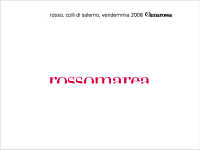
|
|
Rossomarea 2008 |
|
| Lunarossa (Campania, Italy) | |
| Grapes: Aglianico (80%), Merlot (20%) | |
| Price: € 15.00 | Score: |
| Rossomarea shows an intense ruby red color and nuances of garnet red, little transparency. The nose denotes intense, clean, pleasing and refined aromas which start with hints of plum, blackberry and black cherry followed by aromas of dried violet, blueberry, black currant, vanilla, carob and menthol. The mouth has good correspondence to the nose, a properly tannic attack and however balanced by alcohol, good body, intense flavors, agreeable. The finish is persistent with flavors of plum, blackberry and black cherry. Rossomarea ages in barrique for 16 months followed by 8 months of aging in bottle. | |
| Food Match: Stuffed pasta, Broiled meat and barbecue, Roasted meat, Hard cheese | |
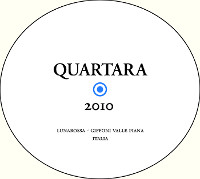
|
|
Quartara 2010 |
|
| Lunarossa (Campania, Italy) | |
| Grapes: Fiano | |
| Price: € 23.00 | Score: |
| Quartara shows an intense golden yellow color and nuances of golden yellow, very transparent. The nose reveals intense, clean, pleasing, refined and elegant aromas which start with hints of apple, plum and hazelnut followed by aromas of mature peach, hawthorn, pear, broom, candied fruits, orange, honey, vanilla and mineral. The mouth has excellent correspondence to the nose, a crisp attack and however balanced by alcohol, full body, intense flavors, pleasing roundness. The finish is very persistent with long flavors of apple, plum and hazelnut. Quartara ferments and ages for 3 months in amphora, followed by 9 months of aging in cask and 6 months in bottle. | |
| Food Match: Stuffed pasta with fish, Roasted fish, Roasted white meat, Mushroom soups | |
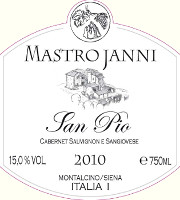
|
|
San Pio 2010 |
|
| Mastrojanni (Tuscany, Italy) | |
| Grapes: Cabernet Sauvignon (80%), Sangiovese (20%) | |
| Price: € 20.00 | Score: |
| San Pio shows an intense ruby red color and nuances of garnet red, little transparency. The nose denotes intense, clean, pleasing and refined aromas that start with hints of black cherry, black currant and violet followed by aromas of blueberry, plum, vanilla, chocolate, tobacco, pink pepper and eucalyptus. The mouth has good correspondence to the nose, a properly tannic attack and however balanced by alcohol, good body, intense flavors, agreeable. The finish is persistent with flavors of black cherry, black currant and plum. San Pio ages for 18 months in cask followed by 6 months of aging in bottle. | |
| Food Match: Stewed meat with mushrooms, Broiled meat and barbecue, Cheese | |
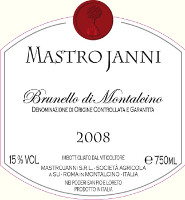
|
|
Brunello di Montalcino 2008 |
|
| Mastrojanni (Tuscany, Italy) | |
| Grapes: Sangiovese | |
| Price: € 36000 | Score: |
| This Brunello di Montalcino shows a brilliant ruby red color and nuances of garnet red, moderate transparency. The nose denotes intense, clean, pleasing, refined and elegant aromas that start with hints of black cherry, plum and violet followed by aromas of blueberry, raspberry, vanilla, dried rose, chocolate, tobacco and menthol. The mouth has good correspondence to the nose, a tannic attack and however balanced by alcohol, full body, intense flavors, agreeable. The finish is persistent with flavors of black cherry, plum and raspberry. Thish Brunello di Montalcino ages for 36 months in cask followed by at least 6 months of aging in bottle. | |
| Food Match: Game, Roasted meat, Stewed and braised meat, Hard cheese | |

|
|
Montefalco Sagrantino Passito Colle Grimaldesco 2008 |
|
| Tabarrini (Umbria, Italy) | |
| Grapes: Sagrantino | |
| Price: € 40.00 - 375ml | Score: |
| Montefalco Sagrantino Passito Colle Grimaldesco shows a deep ruby red color and nuances of garnet red, impenetrable to light. The nose reveals intense, clean, pleasing, refined and elegant aromas which start with hints of blackberry, plum and black cherry followed by aromas of dried violet, blueberry, vanilla, chocolate, tamarind, dried fig, mace, tobacco, nail polish and menthol. The mouth has excellent correspondence to the nose, a tannic and sweet attack, however balanced by alcohol, full body, intense flavors, pleasing roundness. The finish is very persistent with long flavors of blackberry, plum and black cherry. Montefalco Sagrantino Passito Colle Grimaldesco ages for 36 months in barrique followed by 18 months of aging in bottle. | |
| Food Match: Confectionery, Hard cheese, Chocolate desserts | |

|
|
Montefalco Sagrantino Colle alle Macchie 2009 |
|
| Tabarrini (Umbria, Italy) | |
| Grapes: Sagrantino | |
| Price: € 50.00 | Score: |
| Montefalco Sagrantino Colle alle Macchie shows a deep ruby red color and nuances of ruby red, little transparency. The nose reveals intense, clean, pleasing, refined and elegant aromas which start with hints of blackberry, plum and black cherry followed by aromas of violet, blueberry, chocolate, vanilla, tamarind, tobacco, pink pepper, mace, leather and menthol. The mouth has good correspondence to the nose, a tannic attack and however balanced by alcohol, full body, intense flavors, pleasing roundness. The finish is very persistent with long flavors of blackberry, black cherry and plum. Montefalco Sagrantino Colle alle Macchie ages for 36 months in barrique followed by 42 months of aging in bottle. | |
| Food Match: Game, Stewed and braised meat, Roasted meat, Hard cheese | |
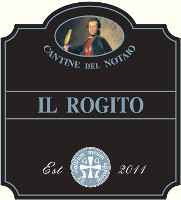
|
|
Il Rogito 2011 |
|
| Cantine del Notaio (Basilicata, Italy) | |
| Grapes: Aglianico | |
| Price: € 13.00 | Score: |
| Il Rogito shows an intense cherry pink color and nuances of cherry pink, transparent. The nose reveals intense, clean, pleasing and refined aromas that start with hints of black cherry, blackberry and blueberry followed by aromas of plum, raspberry, cyclamen, strawberry, rose and vanilla. The mouth has good correspondence to the nose, a crisp attack and however balanced by alcohol, good body, intense flavors, pleasing roundness. The finish is persistent with flavors of black cherry, blackberry and blueberry. Il Rogito ages for at least 12 months in cask. | |
| Food Match: Stuffed pasta, Roasted fish, Fish soups, Roasted white meat | |
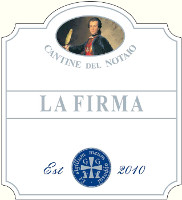
|
|
Aglianico del Vulture La Firma 2010 |
|
| Cantine del Notaio (Basilicata, Italy) | |
| Grapes: Aglianico | |
| Price: € 32.00 | Score: |
| Aglianico del Vulture La Firma shows an intense ruby red color and nuances of ruby red, little transparency. The nose denotes intense, clean, pleasing, refined and elegant aromas which start with hints of black cherry, blackberry and violet followed by aromas of blueberry, plum, raspberry, vanilla, chocolate, tobacco, pink pepper and menthol. The mouth has good correspondence to the nose, a tannic attack and however balanced by alcohol, full body, intense flavors, agreeable. The finish is persistent with flavors of black cherry, blackberry and plum. Aglianico del Vulture La Firma ages for 12 months in cask followed by 12 months of aging in bottle. | |
| Food Match: Game, Roasted meat, Braised and stewed meat, Hard cheese | |
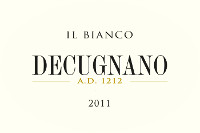
|
|
Orvieto Classico Superiore Il Bianco 2011 |
|
| Decugnano dei Barbi (Umbria, Italy) | |
| Grapes: Grechetto (50%), Procanico (20%), Vermentino (20%), Chardonnay (10%) | |
| Price: € 14.90 | Score: |
| Orvieto Classico Superiore Il Bianco shows a pale straw yellow color and nuances of greenish yellow, very transparent. The nose reveals intense, clean, pleasing and refined aromas which start with hints of apple, plum and broom followed by aromas of peach, pear, kiwi, citrus fruits, hazelnut, hawthorn and mineral. The mouth has good correspondence to the nose, a crisp attack and however balanced by alcohol, good body, intense flavors, agreeable. The finish is persistent with flavors of apple, plum and peach. Orvieto Classico Superiore Il Bianco ages for 7 months in steel tanks. | |
| Food Match: Pasta and risotto with fish and crustaceans, Fried fish, Stewed fish | |
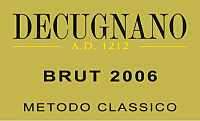
|
|
Decugnano Brut Nature Metodo Classico 2006 |
|
| Decugnano dei Barbi (Umbria, Italy) | |
| Grapes: Chardonnay (80%), Procanico (20%) | |
| Price: € 18.80 | Score: |
| Decugnano Brut Nature Metodo Classico shows a brilliant straw yellow color and nuances of greenish yellow, very transparent, fine and persistent perlage. The nose denotes intense, clean, pleasing and refined aromas that start with hints of banana, apple and bread crust followed by aromas of acacia, yeast, pear, honey, plum, hawthorn and almond. The mouth has good correspondence to the nose, an effervescent and crisp attack, however balanced by alcohol, good body, intense flavors, agreeable. The finish is persistent with flavors of banana, apple and plum. Decugnano Brut Nature Metodo Classico referments in bottle on its lees for at least 60 months. | |
| Food Match: Pasta with fish, Roasted fish, Roasted white meat | |
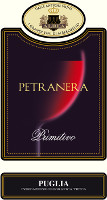
|
|
Petranera 2011 |
|
| Albea (Apulia, Italy) | |
| Grapes: Primitivo | |
| Price: € 14.00 | Score: |
| Petranera shows an intense ruby red color and nuances of ruby red, little transparency. The nose reveals intense, clean, pleasing and refined aromas which start with hints of plum, black cherry and blueberry followed by aromas of violet, blackberry, vanilla, tobacco, carob and mace. The mouth has good correspondence to the nose, a properly tannic attack and however balanced by alcohol, good body, intense flavors, agreeable. The finish is persistent with flavors of black cherry, plum and blackberry. Petranera ages for 6 months in barrique followed by 5 months of aging in bottle. | |
| Food Match: Broiled meat and barbecue, Stewed meat with mushrooms, Hard cheese | |
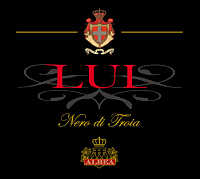
|
|
Lui 2010 |
|
| Albea (Apulia, Italy) | |
| Grapes: Uva di Troia | |
| Price: € 25.00 | Score: |
| Lui shows an intense ruby red color and nuances of ruby red, little transparency. The nose denotes intense, clean, pleasing, refined and elegant aromas which start with hints of black cherry, blueberry and plum followed by aromas of violet, blackberry, raspberry, vanilla, chocolate, mace, tobacco and menthol. The mouth has good correspondence to the nose, a properly tannic attack and however balanced by alcohol, good body, intense flavors, agreeable. The finish is persistent with flavors of black cherry, blueberry and plum. Lui ages for 10 months in barrique followed by 3 months of aging in bottle. | |
| Food Match: Roasted meat, Stewed and braised meat with mushrooms, Hard cheese | |
|
||||||||
|
DiWineTaste Polls
|
| |||||||
Privacy Policy | |||||||


| Copyright © 2002-2024 Antonello Biancalana, DiWineTaste - All rights reserved |
| All rights reserved under international copyright conventions. No part of this publication and of this WEB site may be
reproduced or utilized in any form or by any means, electronic or mechanical, without permission in writing from DiWineTaste. |